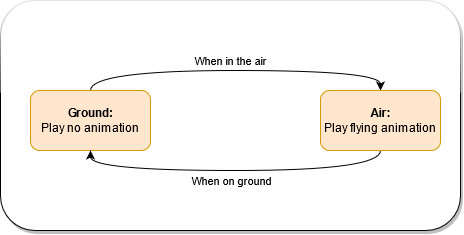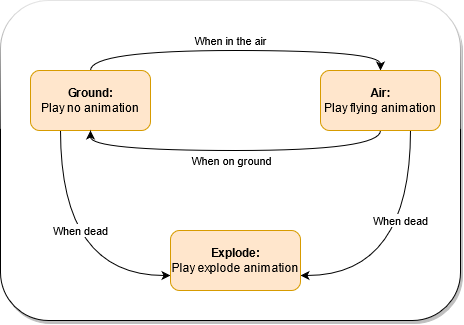Intro to Animation Controllers
Animation controllers (AC) are state-machines that can be used in both the resource pack, and the behavior pack. In the resource pack, animation controllers (RPAC) are used to play animations, and in the behavior pack (BPAC), they are used to play commands, and command "animations".
What are State Machines?
State machines are a special kind of logic management, that relies on a series of states. Each state has two properties:
- What to do in the current state
- How to move to other states
State machines are used all over the place, especially in classical programming. They aren't only found in minecraft! You can learn more about state machines here.
A state machine can only be in one state at a time. When a state machine "runs", you can think of it as moving from state to state, executing the logic inside, and then following transitions to other states.
State Machine example
The reason that state-machines are useful, is they allow us to naturally break up our animations into a logical flow, where each state handles its own animations and its own logic.
For example, imagine you want to animate the spinning blade of a helicopter - but only when on the ground. You have two states:
ground stateflying state
We can annotate these states with the two pieces of information described above:
ground state:- play no animation
- move to
flying stateif in the air
flying state:- play flying animation
- move to
ground stateif on the ground
Here is the state-machine, visualized as a flow-chart:

In this flowchart, states are represented by rectangles, and arrows represent transitions from one state to another.
Flowcharts are a nice way to visualize multi-state finite-state-machines, is it allows you to follow the logical flow of the animation. Let us look at a more detailed example, which adds a third explode state:

As you can see, states can go to more than one state at once. States can also be dead-ends (since the helicopter is dead, and doesn't need further animation). The branching flow of animation-controllers is a large part of what makes them powerful.
What are Animation Controllers?
Animation Controllers are Minecraft state machines that allow us to play animations and run commands. Animation controllers always go under the animation_controllers folder, in either the RP, or the BP.
Attaching our controller to an entity
Animation controller are defined in their own files, and must be "attached" to entities before they can do anything. To attach an AC into your entity, you must do two things:
- Define a short-name for the animation controller
- Run the animation controller via
scripts
Here is a sample description, which shows how the AC can first be defined in animations, and then played in scripts/animate.
"description": {
"identifier": "wiki:helicopter",
"animations": {
"blade_controller": "controller.animation.helicopter.blade"
},
"scripts": {
"animate": [
"blade_controller"
]
}
}If you want to conditionally play an animation controller, you can supply an optional molang argument. If the argument evaluates to true, the controller will play:
"scripts": {
"animate": [
{
// Only play the blade_controller if the helicopter has a rider.
"blade_controller": "q.has_rider"
}
]
}RP Animation Controllers
RP animation controllers go in the RP, and can be attached to RP entities. They allow you to play bone-animations.
BP Animation Controllers
BP animation controllers go in the BP, and can be attached to BP entities. They allow you to play commands and send events to entities.
Animation Controller example
Lets look at a simple animation controller from our State Machine example above:
Simple Example
{
"format_version": "1.10.0",
"animation_controllers": {
"controller.animation.helicopter.blade": {
"initial_state": "ground",
"states": {
"ground": {
"transitions": [
{
"flying": "!q.is_on_ground"
}
]
},
"flying": {
"animations": ["flying"],
"transitions": [
{
"ground": "q.is_on_ground"
}
]
}
}
}
}
}There is... a lot going on here. Lets break it down, step by step. As we do so, remember two things:
- Animation controllers are a list of states
- Each state contains two pieces of information: What to do in any given state, and How to transition to new states.
So this particular example contains two states:
groundflying
You can note that "initial_state": "ground" means that our Animation Controller will begin in the ground state.
"ground": {
"transitions": [
{
"flying": "!q.is_on_ground"
}
]
}The ground state contains a list of transitions, which is how we get to other states. In this example, the default state is saying: Move to the flying state when q.is_on_ground is NOT true. In other words - start the flying animation when we fly into the air!
"flying": {
"animations": [
"flying"
],
"transitions": [
{
"ground": "q.is_on_ground"
}
]
}The flying state also contains a list of transitions. In this case it contains the opposite transition: Move to the ground state when q.is_on_ground is true. In other words - move back to the default state when we land on the ground!
Alongside the transition list, there is also a list of animations to play while inside of this state. In this case, playing the flying animation. This animation will need to be defined in the entity definition file for this entity.
Full Example
Here is the code for the second state machine from above, with three states this time. This example illustrates a few new concepts:
- States with multiple transitions
- States with no transitions
{
"format_version": "1.10.0",
"animation_controllers": {
"controller.animation.helicopter.blade": {
"initial_state": "ground",
"states": {
"ground": {
"transitions": [
{
"flying": "!q.is_on_ground"
},
{
"explode": "!q.is_alive"
}
]
},
"flying": {
"animations": ["flying"],
"transitions": [
{
"ground": "q.is_on_ground"
},
{
"explode": "!q.is_alive"
}
]
},
"explode": {
"animations": ["explode"]
}
}
}
}
}RP Animation Controllers
Resource Pack animation controllers can run things like sounds and particles too. Before calling sound or particle in an animation controller, you need to define them in client entity file.
"sound_effects": {
"explosion": "wiki.custom_tnt.explosion" //where wiki.custom_tnt.explosion is a sound defined in sound_definitions just like animation sounds.
},
"particle_effects": {
"fuse_lit": "wiki:tnt_fuse_lit_particle"
}And only then you can call them in the animation controller:
"states":{
"default":{
"transitions":[
{
"explode_state":"q.mark_variant == 1"
}
]
},
"explode_state":{
"sound_effects":[
{
"effect":"explosion"
}
],
"particle_effects": [
{
"effect": "fuse_lit"
// "locator": "<bone>" Locator can also go here too
}
],
"transitions":[
{
"default":"q.mark_variant == 0"
}
]
}
}Warning! Not every particle works there. If you have problems, consider trying another particle. For example, use one from the blaze animation controller.
BP Animation Controllers
Behavior Pack animation controllers use the same general format as RP Animation Controllers, except instead of triggering animations, they allow you to trigger commands, events, or execute Molang code. In general, they introduce two new fields:
on_entry: Commands to play when the state is enteredon_exit: Commands to play when the state is exited
Commands in this context mean three distinct things:
- A slash command, such as
/say Hello there! - An event trigger, on the entity, such as:
@s wiki:transform_into_plane - An arbitrary Molang expression, such as
v.tickets += 1;(this also works in Resource Pack animation controllers)
Here is an example BP animation controller, which exhibits some of this behavior:
{
"format_version": "1.10.0",
"animation_controllers": {
"controller.animation.helicopter.commands": {
"initial_state": "ground",
"states": {
"ground": {
"on_entry": ["/say I am now in the ground!"],
"transitions": [
{
"flying": "!q.is_on_ground"
}
]
},
"flying": {
"on_entry": ["/say I am now in the air!"],
"transitions": [
{
"ground": "q.is_on_ground"
}
]
}
}
}
}
}Animation Controller Flow
Through the examples, hopefully you are starting to get some concept for how animation controller flow works. In this section, I will explain it more explicitly.
Loading
When an entity loads into the world, it will enter the default animation controller state, in each of its attached animation controllers. If no initial_state is defined, the state named default is used. If this is missing, the AC will generate a content log.
When running, the AC will do the following things each tick:
- Run any animations in the current state (will loop if set to loop, otherwise it will just play once). Run any commands in
on_entry, the state was just entered. - Check all transitions to see if there is any valid transition. Search from the top to the bottom of the list, and move to the first valid transition. If a transition is found,
on_exitcommands will be played.
Because of the way animation controllers are setup, it will only move from state to state at a MAXIMUM of once per tick.
Resetting
Animation Controllers "reset" when an entity reloads (player join/leave, chunk reload, etc). This means that it will "jump" back to the default state. You should always have logic in your default state that can handle restarting any critical animations.
Notes
You can create variables (and remap their values) in animation controllers too!
{
"format_version": "1.17.30",
"animation_controllers": {
"controller.animation.sheep.move": {
"states": {
"default": {
"variables": {
"ground_speed_curve": {
"input": "q.ground_speed",
"remap_curve": {
"0.0": 0.2,
"1.0": 0.7
}
}
},
"animations": [
"wiggle_nose",
{
"walk": "v.ground_speed_curve"
}
]
}
}
}
}
}







